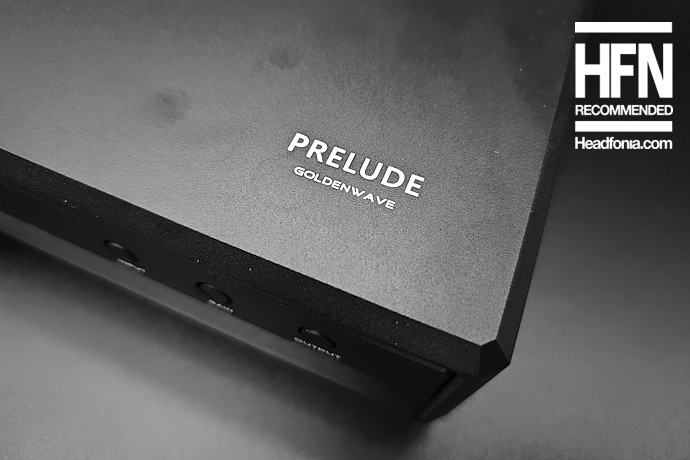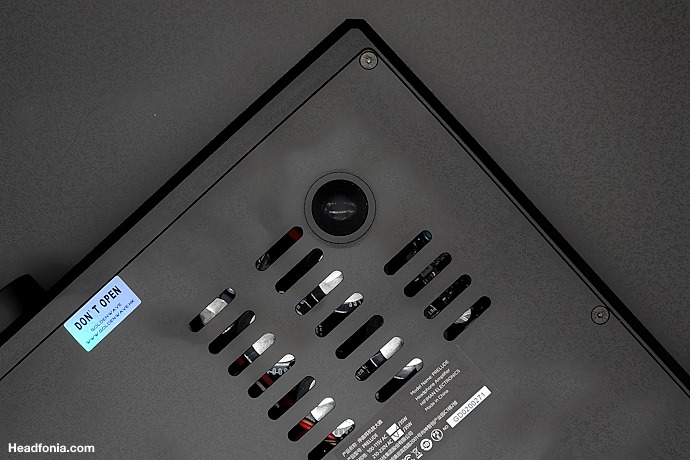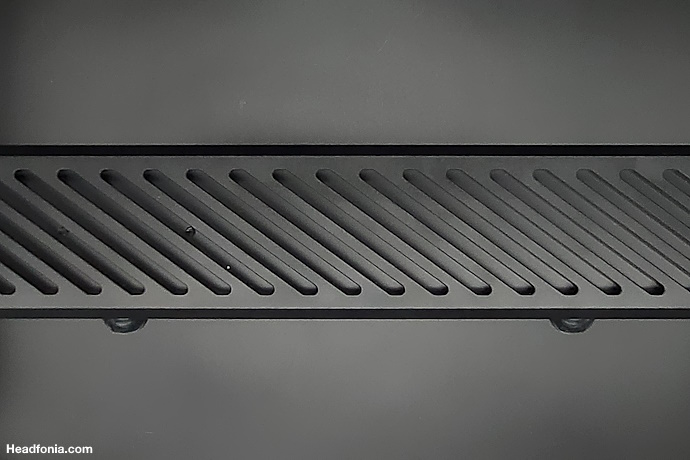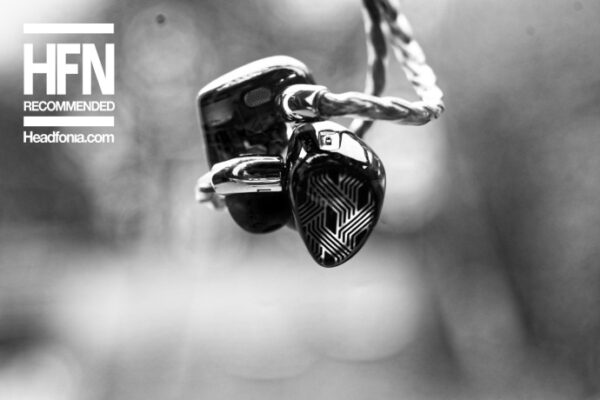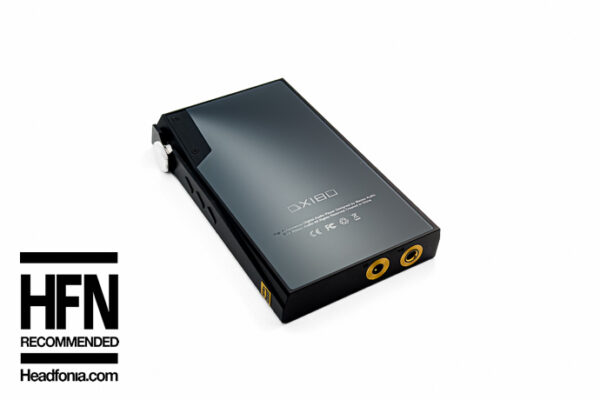If Google is showing you this page directly, click here to go to the start of the article.
Lay-Out and Usability
The lay-out of the Goldenwave Prelude is simple, but that’s actually a good thing. Fron left to right you on the front panel have the double #-pin balanced XLR outputs, which also are regular 6.35mm single-ended outputs. Right next to these you have the balanced 4-pin XLR output and the 4.4mm balanced output. In the center of the front panel, we have the ALPS volume control. On the right end of the unit’s front, we have the input selector (RCA/XLR), the output selector (L/H gain) and the Output selector (Headphone amp or pre-amp).
The back of the unit is more simple than the one on the Serenade as there are no digital connections here. From left to right we have the power button the fuse, the power plug, the CLR and RCA outputs, and the RCA and XLR inputs.
The Prelude headphone amplifier includes multiple Gain options: LOW=0.7V output and HIGH=1V output. When the high gain is selected, the balanced input signal amplitude should be less than 3.6V. When switching the output channel, be sure to keep the volume at the lowest level. Otherwise, you may incur damage to the amplifier or headphone. Note that you can use the headphone outputs at the same time, so you can connect multiple headphones at once. At the same time you can’t run the pre-amp together with the headphone outputs.
Amplification wise the Prelude puts out 10W@32Ω, 6W@64Ω, 2.5W@150Ω, 1W@300Ω and 560mW@600Ω. That means it has plenty of power to drive all of the difficult to drive headphones on the market, and this with ease.
The Hifiman Prelude does easily get hot but it’s never too hot to touch. The vents are situated on both sides of the unit, and you can feel that. I would however make sure the Prelude at all times has enough space to breed. Besides this, there is nothing particular to report here. It’s an easy, straightforward unit and switching gain, input and output are all no-brainers.
Sound Intro
I have used the Hifiman Serenade in multiple setups in my office as well as in my living room setup. I have mostly used it with R2R technology DACs such as the Musician Audio Pegasus and Aquarius. I mostly used the balanced inputs on the back, in combination with both the single-ended as well as balanced outputs of this amplifier. Unless specifically mentioned, the in and out connections used for this review are the balanced ones.
I have used a whole series of easy and hard to drive headphones with different driver types. The most used headphones are the Hifiman HE-1000, the Susvara, the HD 800S, the RAAL 1995 Immanis, the ZMF Caldera Closed, the DCA’s, the JPSLabs Diana MR and the original Audeze LCD-2.1 which I just refurbished. We’ll get into the synergy with these headphones later in this article, but it’s safe to say that the Prelude can drive all of these with ease.
We in this part usually focus on how the companies are describing the sound and performance of their unit, but in this case there besides the “powerful and natural timbre” stated on the Prelude’s website, is very little to be found on that. So let’s get started!
Sound General
To be honest, just like with the Serenade, it is quite easy to describe the Prelude’s sound, as the characteristics are so outspoken. The Hifiman Prelude is a balanced sounding amplifier, and it has a natural, weighty and powerful sound. Prelude’s presentation is smooth, musical and energetic. The stereo imaging is addictive, the noise floor low as we like it and the delivery is clean at all times.
That said, the Prelude also is quite transparent, so it will show you what your source/DAC is all about. With all the sources I tried it with, the Prelude was always strong in dynamics. The Prelude at all times presents a fuller, weighty sound and this from top to bottom. It is very linear this way.
The Prelude also performs (more than) well when it comes to sound stage depth and especially width. The airy mid presentation and nice layering also help in this regard. Where the Prelude suffers a bit more is in clarity and PRaT. Detail wise the Prelude performs as a high-end amplifier should. You get a very detailed presentation but in a non-clinical way. It’s detailed but the micro details aren’t always as proficient because of the weight, slightly lower clarity and full body.
The Prelude’s top end is energetic, full sounding and easier on the ear. At the same time is has good detail and extension, something a headphone such as the Susvara will directly show you. So it is relaxed but precise at the same time.
The mid-section is excellent and you have an airy, spacious presentation with the most lovely, natural timbre. The mids are fuller and smoother in the delivery but they are very musical. The vocals here are perfectly positioned and they have a natural and soft presentation. The mids are a pleasure to the ear and their timbre is one of the best.
The low-end is weighty and impressive but perfectly in control. You get a good impact and punch but bass is never exaggerated. Bass is full, deep and it has excellent layering. It perhaps isn’t the most refined amp in the sub-region but I never found it lacking either.
All-in-all a very solid performance with a dynamic, precise, engaging and musical tuning.
Headphone combos
For this section we used the Prelude in a fully balanced mode and the DAC used is the award winning Aquarius from Musician Audio.
The Hifiman Susvara is an extremely good headphone but it strongly depends on the amplifier used. It needs power and it needs synergy, but get that right and the Susvara will seriously impress. Luckily this combo is one of these that really make the Susvara shine in everything it does, even in low gain mode. A great sound stage in all directions, combined with a highly dynamic, super revealing yet musical presentation. With this setup it’s easy to hear why the Susvara is such an excellent high-end headphone with a top-level technical performance. On top of that the Prelude ads body, weight and dynamics, and it mixes that with a high level of musicality and engagement. Add a smooth and effortless delivery to that and you have the best of everything. I don’t believe in end-game setups myself, but for many this one could be it.
Staying with Hifiman, the HE-1000 to me is the next best thing you can get if the Susvara is out of reach. Again, the synergy between both is exemplary and it is very easy to understand now why Hifiman and Goldenwave are working together. The HE-1000 sounds full, precise and the layering and depth, as well as the mid timbre is as good as it gets. The top-end here is a little less accentuated and extended as in the Susvara, and you overall get a lower energy presence (but that’s typical for the HE-1000 tuning compared to the Susvara). The stereo imaging here is incredible, as is the mid timbre and vocal presentation. Musical, dynamic, effortless, smooth and natural are the keywords here. I could listen to this setup for years and not get tired of it.
The part on sound continues on the last page of the review. Click here or use the link below.
Page 1: Hifiman, Prelude, Specifications, Box, Accessories, Design, Build quality
Page 2: Lay-out, Usability, Sound intro, Sound General, Sound Synergy Pt.1
Page 3: Sound Synergy Pt. 2, Comparison, Conclusion, Summary






